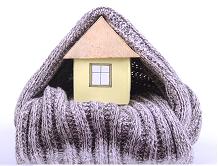
Air leaks in your attic can account for a significant amount of energy loss. The “chimney effect” is what causes indoor air to be pulled up through your house by attic leaks. In winter, when heated air naturally rises, the chimney effect can be worse.
If you’re sealing attic leaks, you’ll need a variety of materials, such as:
- Caulk, for the smaller gaps.
- Expanding spray foam, for larger spaces.
- Heat-resistant caulk, for around flues and chimneys.
- Metal flashing, which must be cut to size for installation around flues and chimneys. Handling flashing can be complicated, so if you have any doubts or questions, call an HVAC expert.
Working around insulation can make the attic sealing job more difficult. Again, if you hit trouble, call in a pro.
An unsealed attic hatch can also pose energy problems, as it is often no more than thin pieces of plywood, so that the attic is easily accessible. However, this thin material and the leaks surrounding it can draw valuable conditioned air out of your living space.
Rigid foam insulation can be installed over the back of the hatch. Duct tape should be enough to secure it. To seal around the hatch, install weather stripping or foam- tape sealant. Place the sticky side against the perimeter of the hatch itself, and another strip against the frame of the hatch. The two strips of sealing material should meet when you draw the hatch closed behind you. If you have pull-down attic stairs, consider investing in an insulated fabric “tent” to cover the staircase and save even more energy.
Done correctly, sealing your attic hatch can save a significant amount of energy. Call Rodenhiser Plumbing, Heating & Air Conditioning if you have questions, or would like a professional touch. We’re happy to keep Norfolk MA comfortable.
Our goal is to help educate our customers about energy and home comfort issues (specific to HVAC systems). For more information about other HVAC topics, download our free Home Comfort Solutions Guide.
Keeping out the cold image via Shutterstock